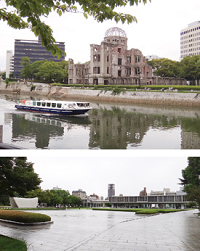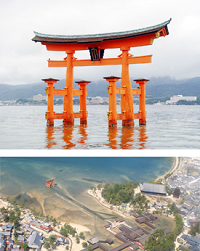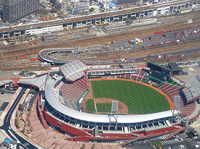Atomic Bomb Dome and Hiroshima Peace Memorial Park
Established in 1915, the Atomic Bomb Dome (Genbaku Dome) in Hiroshima City was originally a commercial pavilion. On August 6, 1945, during World War II, the pavilion was destroyed by the atomic bomb dropped by U.S. forces. Then, having become famous as a memorial of bombing and a symbol of peace, in 1996 the building was designated a UNESCO World Cultural Heritage site. Located adjacent to the Atomic Bomb Dome, Hiroshima Peace Memorial Park was created to send a desire for world peace from Hiroshima, the first city in the world to suffer a nuclear attack. The park is home to the Hiroshima Peace Memorial Museum, the Hiroshima Peace Bell, the Cenotaph for the A-bomb Victims and other many monuments, and attracts visitors from all around the world.

Miyajima and Itsukushima Shrine
Miyajima is regarded as one of the three most scenic spots in Japan. Situated on the calm shore of Seto Inland Sea, Miyajima has been called Kami no Shima (Island of God) since ancient times. On the island are many historical sites such as Itsukushima Shrine, designated as a World Heritage site, and Mt. Misen, where nature has been preserved intact without human intervention. In Miyajima, a variety of festivals and events are held throughout the year, of which the Miyajima Water Fireworks Display is known as one of the largest fireworks events in western Japan. The gorgeous fireworks look more and more brilliant when reflected on the surface of the water, captivating the spectators. In autumn, in Momijidani Park extending along the quietly flowing Momijidani River, multitudes of scarlet maple leaves paint the whole mountain a striking deep red, showcasing autumn in Hiroshima.

Hiroshima Municipal Stadium (MAZDA Zoom-Zoom Stadium)
MAZDA Zoom-Zoom Stadium opened as the second Hiroshima Municipal Stadium in 2009. This stadium is the home-field of the Hiroshima Toyo Carp, a professional baseball team. Since it is a municipal stadium, construction fees were partially covered by funds raised from citizens of Hiroshima, as was the case with the first stadium. The stadium is a beautiful open ballpark with the infield and outfield covered with natural grass. Moreover, it is a socially-friendly and advanced facility, with barrier-free features that adopt a universal design, and actively focuses on environmental conservation by utilizing solar power generation.


 Home
Home